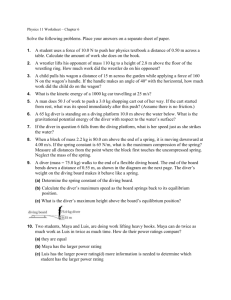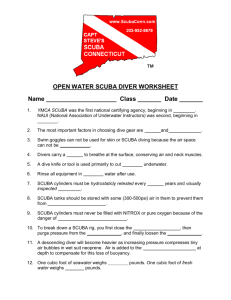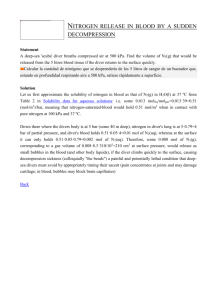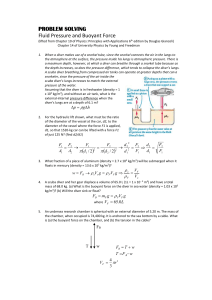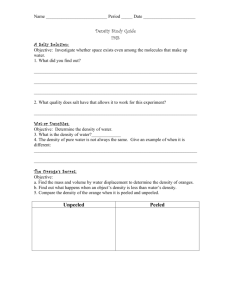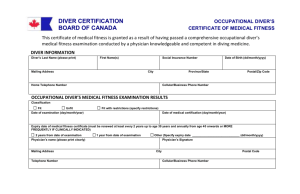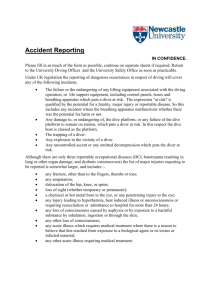Models for Estimating the Diver Population of the United States: An
advertisement
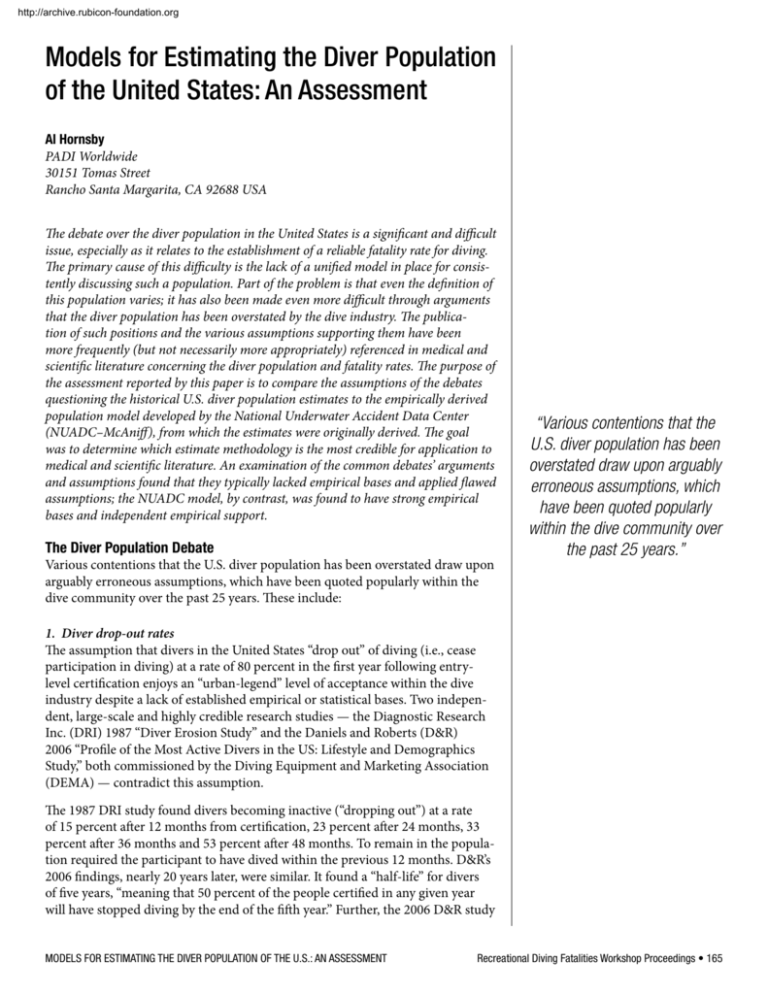
http://archive.rubicon-foundation.org Models for Estimating the Diver Population of the United States: An Assessment Al Hornsby PADI Worldwide 30151 Tomas Street Rancho Santa Margarita, CA 92688 USA The debate over the diver population in the United States is a significant and difficult issue, especially as it relates to the establishment of a reliable fatality rate for diving. The primary cause of this difficulty is the lack of a unified model in place for consistently discussing such a population. Part of the problem is that even the definition of this population varies; it has also been made even more difficult through arguments that the diver population has been overstated by the dive industry. The publication of such positions and the various assumptions supporting them have been more frequently (but not necessarily more appropriately) referenced in medical and scientific literature concerning the diver population and fatality rates. The purpose of the assessment reported by this paper is to compare the assumptions of the debates questioning the historical U.S. diver population estimates to the empirically derived population model developed by the National Underwater Accident Data Center (NUADC–McAniff), from which the estimates were originally derived. The goal was to determine which estimate methodology is the most credible for application to medical and scientific literature. An examination of the common debates’ arguments and assumptions found that they typically lacked empirical bases and applied flawed assumptions; the NUADC model, by contrast, was found to have strong empirical bases and independent empirical support. The Diver Population Debate Various contentions that the U.S. diver population has been overstated draw upon arguably erroneous assumptions, which have been quoted popularly within the dive community over the past 25 years. These include: “Various contentions that the U.S. diver population has been overstated draw upon arguably erroneous assumptions, which have been quoted popularly within the dive community over the past 25 years.” 1. Diver drop-out rates The assumption that divers in the United States “drop out” of diving (i.e., cease participation in diving) at a rate of 80 percent in the first year following entrylevel certification enjoys an “urban-legend” level of acceptance within the dive industry despite a lack of established empirical or statistical bases. Two independent, large-scale and highly credible research studies — the Diagnostic Research Inc. (DRI) 1987 “Diver Erosion Study” and the Daniels and Roberts (D&R) 2006 “Profile of the Most Active Divers in the US: Lifestyle and Demographics Study,” both commissioned by the Diving Equipment and Marketing Association (DEMA) — contradict this assumption. The 1987 DRI study found divers becoming inactive (“dropping out”) at a rate of 15 percent after 12 months from certification, 23 percent after 24 months, 33 percent after 36 months and 53 percent after 48 months. To remain in the population required the participant to have dived within the previous 12 months. D&R’s 2006 findings, nearly 20 years later, were similar. It found a “half-life” for divers of five years, “meaning that 50 percent of the people certified in any given year will have stopped diving by the end of the fifth year.” Further, the 2006 D&R study MODELS FOR ESTIMATING THE DIVER POPULATION OF THE U.S.: AN ASSESSMENT Recreational Diving Fatalities Workshop Proceedings • 165 http://archive.rubicon-foundation.org found that approximately one-third of divers had been certified prior to 1995, can be traced back for 20 years and can be considered “vestigial” divers. A more recent study, the Tauchsport-Industrieverband (tiv) 2010 “FVSFResearch Report No. 31, Diving in the Future,” further supported these findings, concluding that the erosion rate for divers in Germany was 10 percent per annum for divers who did not own their own equipment and 8.5 percent per annum for divers who did own their own equipment. Similarly, the 1998 Leisure Trends “Track on Scuba” found that 14 percent of the diver population had been diving from 10 to 19 years. The application of these empirically derived data to diver certification numbers over the years would support a sizeable, long-term diver population and contradicts an 80 percent first-year erosion rate. “The application of these empirically derived data to diver certification numbers over the years would support a sizeable, long-term diver population and contradicts an 80 percent first-year erosion rate.” 2. Diver certification duplication Another assertion has been of claims of significant duplication among certifications — that divers hold significant numbers of “dual” or multiple training organization certifications for the training, thereby inflating the estimated number of divers. However, the ongoing DEMA Certification Census appears to negate this contention. The current Certification Census is a third-party source for diver certification data, with present participation by the Professional Association of Diving Instructors (PADI), Scuba Schools International (SSI) and Scuba Diving International (SDI) and has included the National Association of Underwater Instructors (NAUI) in the past. Its process identifies and removes duplicate names and addresses across all organizations (and within each organization’s reports) and has found the total duplication rate to average approximately 1 percent. These data show that dual certifications do not appear to exist in sufficient numbers to significantly overinflate diver population estimates. 3. Inclusion of only “active divers” Another confusing element has been the argument that only “active divers” — with some minimum number of dives per year — should be counted in a population model, resulting in a further debate about what level of activity an “active diver” must have. While this is a legitimate area of inquiry for other purposes, it has no application in establishing a population figure to be used as the denominator for overall diver fatality rates. In any fatality rate study, if an individual can be counted as a fatality, that same individual must be part of the population. For this reason, population models that count only those with some specified level of activity are inherently inappropriate for determining fatality rates that count all diver fatalities. When considering introductory scuba experiences, for example, (participants are not certified and therefore are not normally counted in diver population models), this is a significant omission. Based upon the results of a 2003 study by the Flexo Hiner & Partners research firm, PADI can estimate approximately 220,000 introductory scuba participants (those with U.S. residence addresses) annually within its program alone. This large group of diving participants (whose numbers refresh annually on an ongoing basis), while not typically counted in diver population estimates, are typically included in diver fatality counts when the unfortunate incident occurs. The result is a statistically invalid rate. The overall result of applying these common, empirically flawed assumptions to U.S. diver population models has been the publication of diver estimates as low as 700,000. Obviously, the resulting effect on estimated fatality rates is significant. 166 • Recreational Diving Fatalities Workshop Proceedings MODELS FOR ESTIMATING THE DIVER POPULATION OF THE U.S.: AN ASSESSMENT http://archive.rubicon-foundation.org The NUADC – McAniff Population Model The most commonly referenced diver population figure historically used by the dive industry puts the U.S. diver population in the range of 2.7 to 3.5 million participants. This estimate was based on supporting and corroborative empirical elements. It was initially derived from recreational diving’s longest-term diver fatality study, the University of Rhode Island’s National Underwater Accident Data Center (NUADC) program carried out by John McAniff from 1970 through 1994. McAniff established both a population model and fatality rate, summarized in the report “An Analysis of Recreational, Technical and Occupational Populations and Fatality Rates in the United States, 1970–1994” (July 1995). Over the course of the NUADC program, McAniff (whose seminal work is frequently referenced in the literature regarding historical dive accident data) published a report annually, which included both fatality numbers and, as of 1980, rates calculated upon an ongoing diver population model of his design (retroactive to 1970). This work continued until the program was absorbed by Divers Alert Network (DAN); the population model and fatality-rate calculations were not carried forward by DAN. For the U.S. diver population estimate, he used direct certification reporting from the major diver training organizations. (YMCA, NAUI and PADI cooperated with the NUADC study at various times; PADI, for example, contributed U.S. entrylevel certification numbers annually throughout the program.) He also used other data, including an early study titled “An Analysis of the Civil Diving Population of the United States” (approximately 1975), insurance and membership information from the Underwater Society of America, and other sources. He also derived and applied an erosion curve. By maintaining the same approach over the 25 years of his study, McAniff established, at least within the parameters of his data and assumptions, a consistently based, empirically derived population model. In 1995, as referenced in “An Analysis of Recreational, Technical and Occupational Populations and Fatality Rates in the United States, 1970–1994,” McAniff took the additional step of applying the 1987 DRI Diver Erosion Study data to his population data history to establish a new population range model. His original model was consistent with the new and fit within the new range. He subsequently estimated the population of scuba divers in the United States as of 1995 at 2.7 to 3.5 million. This has been the industry’s most frequently quoted diver population figure. “McAniff’s U.S. diver population estimate has performed remarkably well relative to other ongoing empirical diver population studies and reports.” McAniff ’s U.S. diver population estimate has performed remarkably well relative to other ongoing empirical diver population studies and reports. • National Safety Council 1991 Accident Facts — 2.6 million • National Sporting Goods Association (NSGA) 1994 “Sports Participation Study” — 2.378 million (but excludes Hawaii and Alaska) • NSGA 1998 “Sports Participation Study” — 2.558 million • American Sports Data Inc. 1999 “Superstudy of Sports Participation” — 3.2 million • Media Mark Research Inc. 1999 “MRI Sports Trends: Total Scuba Diving Participation” — 2.5 million • Sporting Goods Manufacturers Association (SGMA) 2006 “USA Sports Participation Study” — 2.96 million • SGMA 2008 “USA Sports Participation Study” — 3.216 million MODELS FOR ESTIMATING THE DIVER POPULATION OF THE U.S.: AN ASSESSMENT Recreational Diving Fatalities Workshop Proceedings • 167 http://archive.rubicon-foundation.org The Status of the McAniff Model Since 1995 With McAniff ’s retirement, the updating of his diver population and fatality rate model ceased. However, the empirical data available through ongoing diver population studies continue to support the model’s last (as of 1995) population estimate. Further, given U.S. entry-level diver certifications since 1994, based on the DEMA Certification Census and PADI’s entry-level diver certification history, it does not seem unreasonable to expect that the U.S. diver population as of 2010 remains within, or close to, the 2.7 to 3.5 million range estimated through McAniff ’s model in 1995. Conclusion While there have been varying opinions and assertions regarding estimates of the U.S. diver population, many of these lack empirical support and appear flawed with respect to their use in estimating diver incident and fatality rates. By contrast, the model created by McAniff is based on credible data and methodology and is empirically supported by a continuing series of independent, diver population estimates and corroborations of critical assumptions. Therefore, it appears that McAniff ’s estimate is currently the most suitable figure for use in scientific and medical analyses that require a diver population estimate. Further, it appears that the effort to update the model through the addition of the applicable diver certification data for the years since 1994 would be an important step in deriving an accepted diver population model and estimate for the United States. “It appears that McAniff’s estimate is currently the most suitable figure for use in scientific and medical analyses that require a diver population estimate.” Further Reading McAniff J. “An Analysis of Recreational, Technical and Occupational Populations and Fatality Rates in the United States, 1970-1994,” July 1995. “Scuba injury death rate among insured DAN Members,” Diving and Hyperbaric Medicine, 2008; 38: 182-188. “How Many Divers Are There?” Undercurrents. Diagnostic Research Inc. “Diver Erosion Study,” 1987. Daniels and Roberts. “Profile of the Most Active Divers in the U.S.: Lifestyle and Demographics Study,” 2006. Leisure Trends. “Track on Scuba,” 1998. National Sporting Goods Association. “Sports Participation Study,” 1994. National Sporting Goods Association. “Sports Participation Study,” 1998. American Sports Data Inc. “Superstudy of Sports Participation,” 1999. Media Mark Research Inc. “MRI Sports Trends: Total Scuba Diving Participation,” 1999. Sporting Goods Manufacturing Association. “USA Sports Participation Study,” 2006. Sporting Goods Manufacturing Association. “USA Sports Participation Study,” 2008. Tauchsport-Industrieverband (TIV). “FVSF-Research Report No.3.1 “Diving in the Future,” January 2010. Flexo Hiner and Partners. “2003 PADI Member Survey: Discover Scuba Diving And Discover the Reef Participation Estimate.” “The Editor’s Offering,” Diving and Hyperbaric Medicine, Vol. 37 No. 2, June 2007. Richardson D. “Mortality for Recreational Scuba Diving,” Bennett and Elliott’s Physiology and Medicine of Diving, 5th Edition, 2003. Richardson D. “Reflections on Diver Fatality and Safety Statistics,” SPUMS Journal, Vol. 24 No. 3, September 1994. National Safety Council. Accident Facts, 1991. 168 • Recreational Diving Fatalities Workshop Proceedings MODELS FOR ESTIMATING THE DIVER POPULATION OF THE U.S.: AN ASSESSMENT http://archive.rubicon-foundation.org Discussion UNIDENTIFIED SPEAKER: I have my ex-dive-shop owner hat on. The 225,000 “try” divers a year, where did they go? Because, you know what, I taught 197 to dive every year for seven years. Are we scaring them off in the try dive? AL HORNSBY: I can tell you where a portion of them go. I do not know. It is a phenomenon that we are finding, a recent study we did, that some number of them are continuing to do try dives every year and consider themselves divers. We find they have done a DSD three or four years in a row. They like that supervised, comfortable diving experience, and that is what happened. We have others who tried it, did it, they are gone. It is hard to say. KEN KURTIS: Mentioned earlier today, I enjoy looking at the statistics we have and comparing how each has their own way of validating each thing. I get the Leisure Trends quarterly reports. Some of you do not get that. That is an estimate of what the industry sells. I think the annual total now is around $750 million. If we take 3 million, round numbers, as the number of active divers and divide that into $750 million, which are all dollars that flow through dive shops, travel, masks, training, etc. — does not include stuff you book yourself — we have an average expenditure per diver of $250. Something we know about this industry is wrong. We are pretty sure that divers do not spend just $250 a year. Something is out of whack somewhere. HORNSBY: Could be. I think one of the things with the Leisure Trends study — DEMA was involved with them back in my tenure there — and one of the reasons that the relationship ended is that their sample size was extremely small, these days fewer than 100 stores. So it is an extrapolation based on a very small sample size. Again, I am not to say it is not valid, but that could be a part of this. And, again, the estimate that we are working from, it also is based on — it is what it is. It is what it was based upon. I just think that going forward is the important part. DR. RICHARD VANN: I have one final comment. All of John McAniff ’s diving fatality reports are now on the Rubicon website (http://archive.rubicon-foundation.org) and available to everyone. MODELS FOR ESTIMATING THE DIVER POPULATION OF THE U.S.: AN ASSESSMENT Recreational Diving Fatalities Workshop Proceedings • 169
